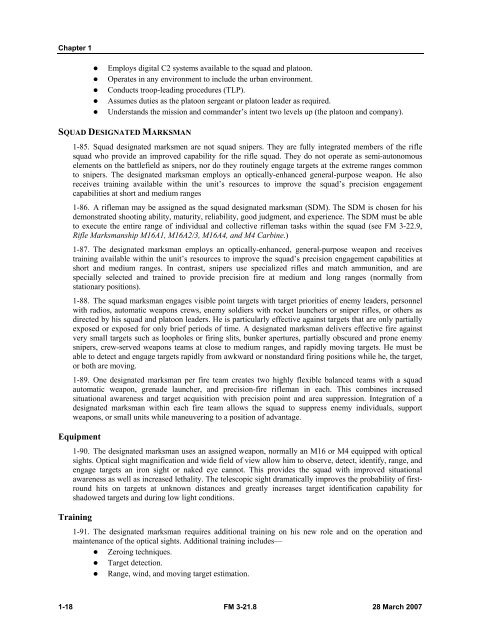Infantry Rifle Platoon and Squad - Sakai
Infantry Rifle Platoon and Squad - Sakai
Infantry Rifle Platoon and Squad - Sakai
Create successful ePaper yourself
Turn your PDF publications into a flip-book with our unique Google optimized e-Paper software.
Chapter 1<br />
• Employs digital C2 systems available to the squad <strong>and</strong> platoon.<br />
• Operates in any environment to include the urban environment.<br />
• Conducts troop-leading procedures (TLP).<br />
• Assumes duties as the platoon sergeant or platoon leader as required.<br />
• Underst<strong>and</strong>s the mission <strong>and</strong> comm<strong>and</strong>er’s intent two levels up (the platoon <strong>and</strong> company).<br />
SQUAD DESIGNATED MARKSMAN<br />
1-85. <strong>Squad</strong> designated marksmen are not squad snipers. They are fully integrated members of the rifle<br />
squad who provide an improved capability for the rifle squad. They do not operate as semi-autonomous<br />
elements on the battlefield as snipers, nor do they routinely engage targets at the extreme ranges common<br />
to snipers. The designated marksman employs an optically-enhanced general-purpose weapon. He also<br />
receives training available within the unit’s resources to improve the squad’s precision engagement<br />
capabilities at short <strong>and</strong> medium ranges<br />
1-86. A rifleman may be assigned as the squad designated marksman (SDM). The SDM is chosen for his<br />
demonstrated shooting ability, maturity, reliability, good judgment, <strong>and</strong> experience. The SDM must be able<br />
to execute the entire range of individual <strong>and</strong> collective rifleman tasks within the squad (see FM 3-22.9,<br />
<strong>Rifle</strong> Marksmanship M16A1, M16A2/3, M16A4, <strong>and</strong> M4 Carbine.)<br />
1-87. The designated marksman employs an optically-enhanced, general-purpose weapon <strong>and</strong> receives<br />
training available within the unit’s resources to improve the squad’s precision engagement capabilities at<br />
short <strong>and</strong> medium ranges. In contrast, snipers use specialized rifles <strong>and</strong> match ammunition, <strong>and</strong> are<br />
specially selected <strong>and</strong> trained to provide precision fire at medium <strong>and</strong> long ranges (normally from<br />
stationary positions).<br />
1-88. The squad marksman engages visible point targets with target priorities of enemy leaders, personnel<br />
with radios, automatic weapons crews, enemy soldiers with rocket launchers or sniper rifles, or others as<br />
directed by his squad <strong>and</strong> platoon leaders. He is particularly effective against targets that are only partially<br />
exposed or exposed for only brief periods of time. A designated marksman delivers effective fire against<br />
very small targets such as loopholes or firing slits, bunker apertures, partially obscured <strong>and</strong> prone enemy<br />
snipers, crew-served weapons teams at close to medium ranges, <strong>and</strong> rapidly moving targets. He must be<br />
able to detect <strong>and</strong> engage targets rapidly from awkward or nonst<strong>and</strong>ard firing positions while he, the target,<br />
or both are moving.<br />
1-89. One designated marksman per fire team creates two highly flexible balanced teams with a squad<br />
automatic weapon, grenade launcher, <strong>and</strong> precision-fire rifleman in each. This combines increased<br />
situational awareness <strong>and</strong> target acquisition with precision point <strong>and</strong> area suppression. Integration of a<br />
designated marksman within each fire team allows the squad to suppress enemy individuals, support<br />
weapons, or small units while maneuvering to a position of advantage.<br />
Equipment<br />
1-90. The designated marksman uses an assigned weapon, normally an M16 or M4 equipped with optical<br />
sights. Optical sight magnification <strong>and</strong> wide field of view allow him to observe, detect, identify, range, <strong>and</strong><br />
engage targets an iron sight or naked eye cannot. This provides the squad with improved situational<br />
awareness as well as increased lethality. The telescopic sight dramatically improves the probability of firstround<br />
hits on targets at unknown distances <strong>and</strong> greatly increases target identification capability for<br />
shadowed targets <strong>and</strong> during low light conditions.<br />
Training<br />
1-91. The designated marksman requires additional training on his new role <strong>and</strong> on the operation <strong>and</strong><br />
maintenance of the optical sights. Additional training includes—<br />
• Zeroing techniques.<br />
• Target detection.<br />
• Range, wind, <strong>and</strong> moving target estimation.<br />
1-18 FM 3-21.8 28 March 2007

















